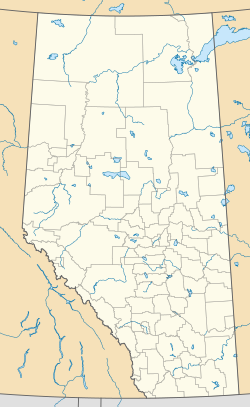Ellscott
Ellscott | |
|---|---|
Hamlet | |
Location of Ellscott in Alberta | |
| Coordinates: 54°30′11″N 112°54′4″W / 54.50306°N 112.90111°W | |
| Country | Canada |
| Province | Alberta |
| Region | Northern Alberta |
| Census division | 13 |
| Municipal district | Athabasca County |
| Government | |
| • Reeve | Doris Splane |
| • Governing body | Athabasca County Council
|
| Area (2021)[2] | |
| • Land | 1.28 km2 (0.49 sq mi) |
| Population (2021)[2] | |
• Total | 5 |
| • Density | 3.9/km2 (10/sq mi) |
| Time zone | UTC-7 (MST) |
| • Summer (DST) | UTC-6 (MDT) |
| Website | www |
Ellscott is a hamlet in northern Alberta, Canada within Athabasca County.[3] It is 3 kilometres (1.9 mi) east of Highway 63, 113 kilometres (70 mi) northeast of Edmonton. It was named after L.G. Scott, a purchasing agent for the Alberta and Great Waterways Railway.[4]
Demographics
[edit]In the 2021 Census of Population conducted by Statistics Canada, Ellscott had a population of 5 living in 1 of its 3 total private dwellings, a change of -50% from its 2016 population of 10. With a land area of 1.28 km2 (0.49 sq mi), it had a population density of 3.9/km2 (10.1/sq mi) in 2021.[2]
As a designated place in the 2016 Census of Population conducted by Statistics Canada, Ellscott had a population of 10 living in 5 of its 6 total private dwellings, an increase from its 2011 population of 0. With a land area of 0.67 km2 (0.26 sq mi), it had a population density of 14.9/km2 (38.7/sq mi) in 2016.[12]
See also
[edit]References
[edit]- ^ "Municipal Officials Search". Alberta Municipal Affairs. May 9, 2019. Retrieved October 1, 2021.
- ^ a b c d "Population and dwelling counts: Canada and designated places". Statistics Canada. February 9, 2022. Retrieved February 10, 2022.
- ^ "Specialized and Rural Municipalities and Their Communities" (PDF). Alberta Municipal Affairs. June 3, 2024. Retrieved June 14, 2024.
- ^ Boyle and District Historical Society (1982). Forests, furrows and faith : a history of Boyle and districts. Boyle. p. 25. Archived from the original on September 24, 2015. Retrieved August 12, 2013.
{{cite book}}: CS1 maint: location missing publisher (link) - ^ 1981 Census of Canada (PDF). Place name reference list. Vol. Western provinces and the Territories. Ottawa: Statistics Canada. 1983. Retrieved September 26, 2024.
- ^ 1986 Census of Canada (PDF). Population. Vol. Unincorporated Places. Ottawa: Statistics Canada. 1988. Retrieved September 26, 2024.
- ^ 91 Census (PDF). Population and Dwelling Counts. Vol. Unincorporated Places. Ottawa: Statistics Canada. 1993. Retrieved September 26, 2024.
- ^ 96 Census (PDF). A National Overivew: Population and Dwelling Counts. Ottawa: Statistics Canada. 1997. Retrieved September 26, 2024.
- ^ "Population and Dwelling Counts, for Canada, Provinces and Territories, and Census Divisions, 2001 and 1996 Censuses - 100% Data (Alberta)". Statistics Canada. August 15, 2012. Retrieved September 19, 2024.
- ^ "Population and dwelling counts, for Canada, provinces and territories, and designated places, 2006 and 2001 censuses - 100% data (Alberta)". Statistics Canada. July 20, 2021. Retrieved September 19, 2024.
- ^ "Population and dwelling counts, for Canada, provinces and territories, and designated places, 2011 and 2006 censuses (Alberta)". Statistics Canada. February 8, 2012. Retrieved September 19, 2024.
- ^ a b "Population and dwelling counts, for Canada, provinces and territories, and designated places, 2016 and 2011 censuses – 100% data (Alberta)". Statistics Canada. February 8, 2017. Retrieved February 13, 2017.

